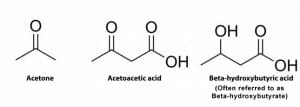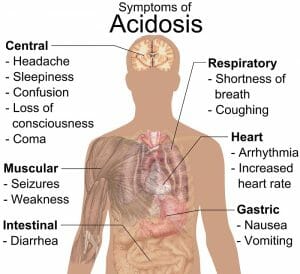Ketone Bodies Definition
Ketone bodies, or simply ketones are substances produced by the liver during gluconeogenesis, a process which creates glucose in times of fasting and starvation. There are three ketone bodies produced by the liver. They are acetoacetate, beta-hydroxybutyrate, and acetone. These compounds are used in healthy individuals to provide energy to the cells of the body when glucose is low or absent in the diet.
Above are the three ketone bodies. Acetone (left), acetoacetate (middle), beta-hydroxybutyrate (right).
Why Are Ketone Bodies Formed?
When glucose levels are high in your body, it is busy storing the excess as fats, building proteins, and in general growing. This is known as the absorptive state. When you fast, or are being starved, the glucose levels in your blood quickly decrease. This triggers the body to enter the postabsorptive state. In this state, the body starts converting fat back to fatty acids, glycogen into glucose, and even starts breaking down amino acids for energy.
While glycogen is just a storage product of glucose and can be quickly converted back, only so much glycogen is stored in the body (mainly in the liver). Once these stores are depleted, the body must resort to the other breakdown products for energy. Luckily, most of the cells in the body can survive off of fatty acids, created from the breakdown of fat. This is not true, however, for the brain and liver. The brain cannot receive fatty acids, which cannot pass through the blood-brain barrier. The liver, in order to keep supplying the brain with glucose, must convert amino acids, glycerol, pyruvate, and lactate into glucose. This process is called gluconeogenesis, and also produces the two ketone bodies acetoacetate and beta-hydroxybutyrate. It releases these ketone bodies, along with glucose, into the blood stream to feed the brain. By this point, the muscles and other organs have mainly switched to fatty acids for energy, conserving the glucose for the brain. This is known as glucose sparing, and is very important for animals which must undergo long periods of fasting or starvation.
The brain prefers glucose as a source of energy, but will begin to switch to ketone bodies after about 4 days of starvation. This greatly increases the amount of time an organism can go without food, however it can also begin to cause negative side-effects. If food is not eaten to replenish the glucose supply, ketone bodies can begin to build up. When this happens, acetone is formed from the spontaneous breakdown of the other ketone bodies in the blood. Acetone is a volatile and reactive substance. When it begins to build up in the blood it can lower the pH of the blood, a condition called acidosis. Acidosis affects nearly all bodily tissues, reducing their function and messing with the enzymes of the body, which rely on a specific pH balance. Ketoacidosis, or acidosis caused by excessive ketone bodies, will lead to coma or death if not reversed.
Ketone Bodies in Diabetes
Diabetes is a condition in which the body cannot or will not produce insulin, an important molecule in the glucose cycle. Insulin signals to the cells of the body to uptake the glucose in the blood and use it for energy. In those with diabetes, this signal is not present and without artificial insulin, the glucose will stay trapped in the blood. Not only can the cells of the body not get energy, but glucose also holds the base molecule for many other cellular activities. Without glucose in the cells, the body begins to uptake fatty acids from the blood, to provide the energy.
The lack of glucose also triggers the liver to begin making glucose. As this happens, ketone bodies are release, just as in a regular person. However, a diabetic person has a compounded problem. Ketone bodies can be used for energy, but only if the proper intermediaries are present. These usually come from the breakdown of glucose. But, in a diabetic, very little glucose has been broken down. This means that even the ketone bodies cannot be used for energy. As such, they begin to build up relatively quickly.
This causes a sudden and severe ketoacidosis. Diabetes is often diagnosed by the smell of acetone or fruit on a person’s breath and highly acidic, acetone laden urine. These signs indicate severe ketoacidosis and could be life-threatening. Luckily, a dose of insulin will allow the blood glucose levels to drop, the intermediates required will be created from the breakdown of glucose, and the ketone bodies will be cleared out of the system in a short time.
Ketone Bodies in Dieting and Starvation
Interestingly, some recent fad diets have come under scrutiny for causing ketoacidosis in people who practice them. These diets focus on low carbohydrates and high protein. Because carbohydrates are complex forms of glucose, removing them from the diet effectively removes glucose from the diet. This works for a little while, because the body is required to get the energy it needs from fat. However, consider the case of the diabetic, and think about why this might be a terrible idea.
Without blood glucose, the cells in the body are again required to survive off fatty acids, derived from stored triglycerides. The brain cannot survive off of these fatty acids, and the liver must undergo gluconeogenesis to produce glucose for the brain. While it does this, it also produces ketone bodies. For short periods of time, the body is able to derive its energy this way. But, as the glucose levels get lower and lower, so do the intermediates required to utilize ketone bodies as energy. Eventually, more ketone bodies will be made than can be used, and they start to build up.
Even when a person is still eating on these diets, the complete lack of carbohydrates makes it incredibly hard for the body to keep up, and acidosis begins to occur. Much like in someone with diabetes, the level of acetone in the urine will increase and the breath may smell sweet or like acetone. The creators of these diets often call this a “common dieting problem”, but ketoacidosis is not common in healthy people and forcing your body into that state is dangerous. Above are some of the listed symptoms acidosis may cause. Further, it has been found that an acidosis of the blood can lead to less calcium uptake from the diet and deposition into the bones. This means that not only are you basically starving yourself, you are also weakening your bones.
Quiz
1. Which of the following is a positive effect of ketone bodies?
A. Lowers blood pH
B. Provides cells with energy
C. Can degrade into acetone
2. Why are ketone bodies created?
A. On accident, as a by-product of creating glucose
B. To lower the blood pH
C. As an energy source for use anytime
3. You are looking into the Bacon Diet, a new fad some of your friends are doing. In this diet, you eat only bacon for all 3 meals, and drink only water in between. Why is this a bad choice?
A. Bad choice? This sounds awesome!
B. The excess protein and lack of carbohydrates will cause ketoacidosis.
C. Bacon is expensive
References
- Campbell, T. C., & Campbell, T. M. (2006). The China Study. Dallas: Benbella Books.
- Nelson, D. L., & Cox, M. M. (2008). Principles of Biochemistry. New York: W.H. Freeman and Company.
- Widmaier, E. P., Raff, H., & Strang, K. T. (2008). Vander’s Human Physiology: The Mechanisms of Body Function (11th ed.). Boston: McGraw-Hill Higher Education.
Ketone Bodies


No comments:
Post a Comment